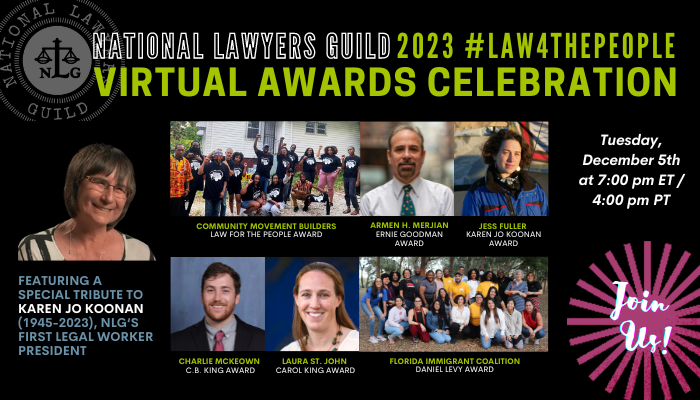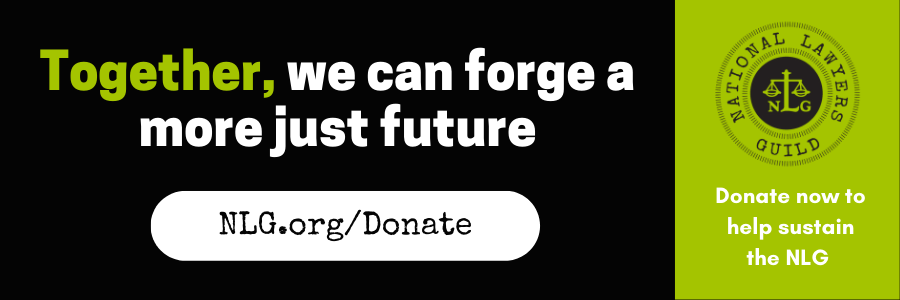In 2020, the NLG membership passed the Resolution Supporting the Abolition of Policing, in which the NLG calls for “the defunding, dismantling and abolition of all forms of policing.” To provide clarity on this policy, the resolution’s proponents and the NLG National Office are sharing this FAQ to help members understand and incorporate the new policy into their work.
We also hope this is helpful in light of continued oppression by law enforcement and ongoing calls from community members to abolish policing in response—we know reform is not enough.
This is a living document. If you have additional questions you’d like to see answered in this FAQ, please contact antiracism@nlg.org
Frequently Asked Questions
What about protecting people’s safety in the face of immediate physical danger? (e.g. calling 911)
- Fire trucks, ambulances, and other emergency services should be dispatched without police. People call 911 and police show up when really people just need a tow truck. Police do not protect people’s safety, but 911 is the easiest number to memorize. Groups around the country have compiled “who to call instead of the police” info-sheets. Look for a resource specific to your locality. If you can’t find anything, consider connecting with organizers and advocates in your area to create something! Consider also doing advocacy in your town to end practices of police involvement in local social service organizations, and/or creating formal organizations or dispersed networks who are trained in trauma-informed de-escalation, basic medic skills, how to administer Narcan, and other needed services.
- Externalizing the intervention in emergencies and other situations that call for people with medical/deescalation/generative conflict/bystander intervention skills is something abolitionists caution against. Prominent abolitionists are calling for people to learn skills and practice interventions in a variety of scenarios without just calling a hotline (even if it’s a non-police one), because our communities can and must build the capacity to take care of each other. Mariame Kaba is highlighting this with the call of 1 Million Experiments to keep each other safe.
- In addition, this resolution calls for the abolition of “policing” instead of just the “police,” because we know that social workers, Departments of Child & Family Services/Child Protective Services can and do engage in forms of policing, particularly against Black people. Policing is a social relation that involves coercive power, which means that anyone has the ability to engage in it depending on the situation. Therefore, reading, going to workshops, and skill building and sharing are all critical pieces of practicing abolition.
What about community-based efforts like Civilian Review Boards?
- CRB’s are not abolitionist measures because they do not decrease police funding, authority, or presence in a community. CRBs legitimize police by claiming that the institution of policing can be a positive contribution to a community, if only policing is “done better.” This ignores that policing as an institution is inherently problematic, beyond its operation. For a more thorough description on why “reformist reforms” are counter-productive and for tips on how to identify and avoid them, see this chart from Critical Resistance.
How do we support families impacted by police murder calling for prosecution?
- We should be in transparent and respectful solidarity with families impacted by police murder and respect their rights to define accountability and justice for themselves. We should not seek to silence families calling for prosecution of a cop who has murdered their loved one. However, we can refrain from joining or amplifying that call for prosecution. If asked by a directly impacted family member or loved one to support calls for prosecution, such as by signing a petition or co-sponsoring a protest where this is a demand, this can be a challenging situation to navigate. We should strive to be clear but sensitive about this boundary and why we don’t support prosecution, while finding ways to stay supportive of people in healing on their own terms from the trauma and grief of police violence. What other ways has the family requested support? Instead of sharing a petition calling for the indictment of XYZ murderous cop, we could ask the family members if they have a donation link for funeral or other expenses and promote that. We can amplify the family’s demands that align with our politics (such as calls to defund the police department).
- Be open, gentle, and communicative when sharing abolitionist perspectives around prosecuting killer cops, especially if you are talking to someone who has been directly harmed by police murder.
Is it abolitionist to call for “investigations” but not necessarily prosecution?
- Using state resources to determine “guilt” is police and prison logic. Investigations are the precursor to prosecutions, and involve the state applying (and attempting to legitimize) its definitions of criminality which are rooted in anti-Blackness, classism, ableism, xenophobia, etc. Just because the investigation might in one instance be against someone who has actually caused harm, does not excuse the reality that investigations as a tool are ultimately part of an inherently oppressive system.
What would non-prosecutorial accountability for right-wing violence or insurrectionists look like?
- In general, non-prosecutorial responses look to increase safety for people who are immediately at risk or are currently being threatened/attacked, and also to examine and address the reasons that these attacks happen.
- Harm reduction and safety can look like many things depending on the severity of the violence, resources available to the people being targeted, and other personal and community circumstances. No one harm reduction strategy will be right for everyone. For example, getting a gun and learning how to use it might make one person who is being targeted by white supremacists feel safer, but others may feel less safe having a gun nearby. Another issue is whether the targeting is happening to one specific high-profile organizer, or whether right-wingers show up at protests to target larger groups of people. Physical and emotional security measures for individual or group targets of fascist violence might include self-defense and security culture trainings, group security details at actions, and clear community guidelines on how to interact (or to specifically not interact) with known fascists so as not to escalate situations. Another tactic is deplatforming bigots who threaten or use violence, such as tech security folks discovering and posting people’s names and employers online, thereby removing the anonymity that can sometimes enable fascist violence. As with any harm reduction or mitigation effort, we should be victim-centered and take cues from the people who are most directly affected as to what will make them feel safer.
- Addressing the root problem of right-wing bigotry will not happen through the punishment logic of the state or through mobilizing police, because these are institutional tools that prop up white supremacy in our society in the first place. The state benefits by conditioning poor white people who are disenfranchised by their government to be anti-Black, xenophobic, racist, and transphobic, and to approach liberation, security, and respect with a scarcity mindset — as exemplified in the destructive reasoning that saying Black Lives Matter means white lives shouldn’t, or that immigrants “steal jobs.” For white anti-racists especially, if you have the capacity to do this you can and should connect with white people who are (or are on their way to becoming) violent fascists and to have conversations that counteract white supremacist ideology through relationship building and political education. Meeting people where they’re at, acknowledging their own suffering and that their own needs aren’t being met, and pointing to the real root causes of oppression might be more effective to deter fascist violence than using tools of white supremacy (prosecutions) to “teach people a lesson” for being racist.
What does accountability look like in the international sphere for human rights violations/humanitarian crimes?
- At the end of the day, an international criminal court has the same problems as US courts writ large, albeit with very different histories. Similarly to how prosecutors charge police with murder as a way to quell bottom-up rebellion (but rarely convict officers), these scraps of recognition fueling our hope that the system is “working” legitimize the oppression the system otherwise enables. International prosecution is just another way of saying “don’t try to achieve justice for yourself, let a higher authority decide what harms are ‘criminal’ and what harms you must accept.” Prosecution at any level is a deliberately and almost categorically ineffective “answer” to very real and catastrophic problems, but by putting faith in it we are reinforcing its value in the first place.
- While we need accountability for people who do horrific things, this is not going to come by administering punishment or even “consequences” as determined by institutions like the United Nations who are driven by hierarchical power structures, when such power is acquired and maintained through imperialist and colonialist violence. The ICC exemplifies some of these problems because it selectively prosecutes people in the continent of Africa and doesn’t do much or anything to recognize western imperialist countries as perpetrators of war crimes. Joe Biden won’t be prosecuted for bombing Syria, so having an ICC provides a false sense of “accountability” that channels energy away from more direct forms of justice and towards “peaceful” AKA enabling, processes.
Is it abolitionist to call for reforms on immediately dangerous prison conditions?
- Yes, it can be! Reforms to dangerous prison conditions can reduce harm in the short term. Similar to the analysis with police reforms, immediately dangerous prison conditions should be reformed with the goal of taking funding and resources away from the corporations and governments that run the PIC and giving direct relief and respite to people suffering in the PIC. For example, prison reforms that require the construction of new prison buildings and facilities or the expansion of prison contracts are ultimately cementing the power of the PIC. In contrast, prison reforms that expand rights of and protections for people on the inside (i.e. access to classes and programming, better food, prohibiting particularly violent forms of torture like solitary confinement and the death penalty) are an important interim step towards completely abolishing prisons.
How do we talk about consequences for recent surges in anti-Asian & anti-Black interpersonal violence?
- First off, we are choosing the intentional language of “anti-Asian, anti-Black, etc. violence,” as opposed to “hate crimes,” because the latter term has been constructed by the state to obfuscate how this violence is facilitated by the state. Racialized harm and violence that happens on an interpersonal scale (i.e. a white person attacking a person of color) is not separate from structural white supremacy that imperialist nations (especially the U.S.) rely on to maintain power. In addition, abolitionists do not use the language of “crime,” because we know that the state uses that term & concept to uphold notions of Blackness, queerness, poverty, etc. as “criminal.”
- Distinguishing self-defense (and consequences) from punishment is important when planning responses to racist violence. Prison logic, which is rooted in white supremacy, ingrains in us that punishment is the appropriate response to someone causing harm. When planning a response to a “hate crime,” imposing “punishment” is not the most effective strategy for healing the victim or neutralizing the threat of a future attack, but to the contrary actively contributes to a major cause of the harm, which is white supremacy culture. However, people and communities can impose consequences and employ self defense as strategies designed to block immediate and future acts of violence. These are very important strategies to avoid or reduce harm, and do not replicate prison logic in the same way as punishment (or revenge).
- One question to ask might be: what is the least invasive means we can use to stop this harm from happening? When someone is using a position of power or employment as a platform to spout racism, taking that platform away is an appropriate consequence and is not a punishment. If someone’s access to a group enables their abuse, removing that access can be a consequence. Consequences can be initiated immediately and without warning or, if someone in your community has a connection they feel comfortable using to engage the aggressor in dialogue, consequences can be imposed gradually, as part of a conversation, and escalated as needed. Sometimes the victim of the racist violence might want a highly public response, such as a public action denouncing the act and/or the aggressor.
- Acts of racist interpersonal violence are visible manifestations of white supremacy culture. Maintaining white supremacy culture is a primary function of police and prisons. A root cause of white supremacy culture cannot be a solution to a particularly noticeable and violent symptom of white supremacy culture.
What does it mean re: civil liberties/accountability?
- As framing, we must emphasize that, from an abolitionist perspective, accountability cannot come from state actors whose existence is to use violence to uphold systems of oppressive power. True accountability requires an intervention in and halting of the harm/violence being caused, and that cannot happen while police exist. No matter what types of reforms are implemented, police are going to continue to cage, control, harass, attack, and murder Black, Indigenous, and other colonized and oppressed people.
- When pursuing civil remedies in court, abolitionists can ask ourselves the same questions we ask when calling for police reforms. Does the remedy diminish the life and scope of policing? Does it take money, legitimacy, and/or power away from the police department and bring it back towards the community? If so, this civil claim, like a reform, can be in line with abolitionist politics. For example, when a police officer murders someone, a claim brought under 42 USC 1983 may redirect resources towards the community in the form of monetary damages. However, civil claims must be brought with an awareness that any appeal to the court system, whether civil or criminal, is an appeal to a system rooted in genocidal, settler-colonial origins and set up to protect the status quo of hoarded wealth and white supremacy. We must hold a nuanced perspective here — the civil rights movement was an incredible, world-changing liberatory effort led by radical Black organizers whose work abolitionists benefit from and build on to this day. The US government co-opted much of the revolutionary energy of the civil rights era to pass reforms in order to preserve itself.
- Ultimately, we know that judges are not neutral, because the US judicial system of stare decisis locks courts to the precedent of their violent and oppressive history. Nor should the limited remedies outlined in federal or state civil rights legislation be considered sufficient, when the protections are microscopic in comparison to the exploitation and violence against Black, Indigenous, and people of color, immigrant, disabled, trans queer and/or gender nonconforming, women, and poor people that our current legal system not only allows but is actively set up to facilitate. Not to mention the inaccessibility of the process of getting a lawyer and going to court.
- TLDR: Civil rights lawsuits are not solutions to any systemic causes of oppression, but can be harm reduction tactics when applied with a critical analysis of their origins and the limits of their utility.
Further Resources:
- 2020 NLG Police Abolition Resolution & Related Press Release
- #8toAbolition Website & Resources & NLG Statement Supporting #8toAbolition
- Critical Resistance’s ‘Abolish Policing’ Resource tab
- “How I Became a Police Abolitionist” by Derecka Purnell
- “The Fantasy of Community Control of Police” by Woods Ervin, Ricardo Levins Morales, Zola Richardson & Jonathan Stegall
- “Yes, We Mean Literally Abolish the Police” by Mariame Kaba
- [NLG WEBINAR] Implementing Abolition: How to Create Just & Lasting Decarceration (4/9/19)
- 2015 NLG Prison Abolition Resolution & Related Press Release
- INCITE! Women of Color Against Violence
- Black and Pink
- Everyday Abolition / Abolition Everyday Interview with Leroy Moore
- UndocuBlack Network
- Black Alliance for Just Immigration
- Why Freedom for Immigrants believes in abolishing immigration detention
- Prison Abolition Syllabus by AAIHS



